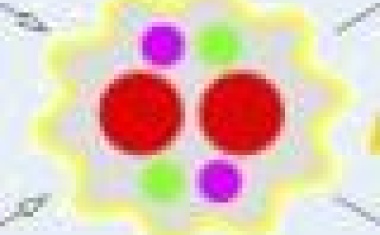
Mehr Energie durch Fusion schwerer Baryonen
Neuanordnung schwerer Quarks in exotischen Elementarteilchen mit positiver Energiebilanz.
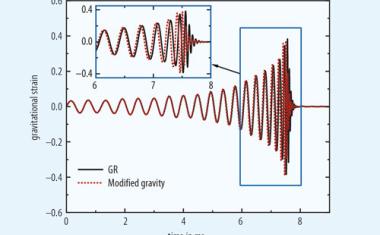 • 9/2024 • Seite 76 • DPG-Mitglieder
• 9/2024 • Seite 76 • DPG-MitgliederGravitational waves promise to shed light on fundamental physics through observations of dark compact objects.
Gravitational waves provide a unique window into the most cataclysmic events in the universe, from the Big Bang to black hole mergers. They complement traditional electromagnetic astronomy and, in addition, reveal phenomena that were previously hidden from our view.
The direct detection of gravitational waves in 2015 [1] was among the most important discoveries in fundamental physics in recent decades and a proof of one of the fundamental predictions of General Relativity (GR). The signal was observed by the two underground LIGO detectors in Hanford and in Livingston (Fig. 1); the comparison of the data in the bottom plot demonstrates that both detectors witnessed the same event. At least two detectors operating simultaneously are needed to confirm the detection because these instruments are so sensitive that various noises might contaminate the signal, such as seismic activities or even animals walking on the ground above the detector. In addition, it is very important that the observed signal matches the theoretical prediction very well. This is a confirmation that the observed gravitational wave event is a merger of two compact objects with spacetime curvature in their vicinity reaching extreme values. Even though a number of exotic scenarios cannot be excluded, the most probable one is that these were two colliding black holes. (...)
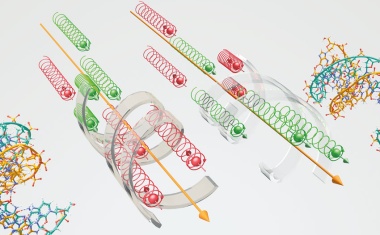 • 6/2023 • Seite 31 • DPG-Mitglieder
• 6/2023 • Seite 31 • DPG-MitgliederSpinselektive Transmission von Elektronen in chiralen Systemen
Chiralität bedeutet, dass Teilchen nicht mit ihrem Spiegelbild zur Deckung zu bringen sind. Chirale Systeme, wie oligo-DNA-Moleküle oder Helicen, weisen eine spinabhängige Photoelektronen-Transmission auf und können somit als eine Art Spinfilter wirken. Damit eignen sie sich etwa für das Design organischer spintronischer Bauteile oder liefern wichtige Erkenntnisse über den Elektronentransfer in Biomolekülen.
Elektronen besitzen neben ihrer Ladung ein intrinsisches magnetisches Moment, das 1922 im Stern-Gerlach-Experiment nachgewiesen wurde. Dieses lässt sich auf eine quantenmechanische Eigenschaft des Elektrons zurückführen: Den Spin, der formal einem Eigendrehimpuls entspricht. Er ist in zwei Werte sz = ± ħ/2 quantisiert. Der Spinvektor kann in alle drei Raumrichtungen zeigen; seine Projektion auf eine beliebig gewählte Quantisierungsachse nimmt jedoch immer den positiven (spin up, parallel) oder den negativen Wert (spin down, antiparallel) an. 1928 zeigte Paul Dirac, dass ein solcher Freiheitsgrad direkt aus der relativistischen Beschreibung der Elektronenbewegung im Atom folgt. Der Spin von Elektronen koppelt mit dem Bahndrehimpuls im Atom oder Molekül; die Kopplung wächst sehr stark mit der Kernladungszahl.
Effekte, bei denen die Ausrichtung des Spins eine Rolle spielt, sind also eher nicht bei organischen Molekülen zu erwarten, die hauptsächlich aus leichten Atomen wie Kohlenstoff und Wasserstoff bestehen. Dennoch weisen in jüngster Zeit viele Experimente an Filmen helikaler organischer Moleküle auf eine sehr hohe Spinpolarisation der durch sie transmittierten Elektronen hin. In Monolagen solcher Moleküle treten bei Raumtemperatur longitudinale Spinpolarisationen von 60 bis 80 Prozent auf. Was führt zu dieser überraschenden Beobachtung?
Chirale Moleküle und Systeme gibt es bei identischem Aufbau in zwei Klassen, die durch Spiegelung nicht ineinander überführbar sind, den Enantiomeren (Infokasten). Sie machen einen großen Teil unserer natürlichen Umgebung aus. Alle biologischen Systeme auf der Erde nutzen nur genau eine Enantiomerenform der relevanten Moleküle, die meistens in Form von α-Helizes vorliegen. Bekannte Beispiele sind die DNA, Proteine, Peptide, Aminosäuren und Zucker. An Zuckerlösungen lässt sich in einem einfachen Experiment die Wirkung chiraler Moleküle und Strukturen auf linear polarisiertes Licht beobachten, dessen Polarisationsrichtung sich beim Durchgang dreht. (...)
Oliver Dreissigacker, Stephanie Nickl (Wiley VCH)
Carlos Lee (EPIC)
Carlos Lee, EPIC’s director general, talks to Marc Ricci, general director of Pôle Optitec, a cluster based in southern France dedicated to innovative photonics technologies.
The Laser World of Photonics is celebrating its 50th anniversary and, for the first time, it will take place alongside Automatica, the leading exhibition for smart automation and robotics. Exhibition director Anke Odouli offers a glimpse of the innovations, key topics and highlights of the laser event.
Optisense turns twenty-five and is in its prime, stating that it is the market leader in non-contact coating thickness measurement.
The company’s history dates back to 1970, when Stephen J. Botos and two fellow engineers started prototyping a positioning system for industrial use in a garage. The first positioning system manufactured was a simple two-axis electromechanical application. A lot has happened in the past fifty years: the former 3-man start-up has grown into a high-tech company with over 500 employees. We spoke with CEO Mark Botos and Aerotech president Bob Novotnak about the company's development into a key player in the market for high-precision positioning systems and where the journey is still heading.
From the supposedly ‘better flashlight’ to high-performance systems for industrial materials processing: the diode laser has traced a remarkably successful path over the last two and a half decades. And there is still no end to this development in sight.
Laser technology plays an important role in the history of Trumpf and to the present day, from the first laser cutting machines to lasers for EUV lithography. This is how Trumpf made the laser suitable for industry and how the high-tech company benefits today from courageous decisions
Combining light and water created a hybrid method of laser machining superior to other technologies, trade-marked as Laser MicroJet. The water cools the cutting zone so that hard and brittle materials can be machined without any thermal damage.
Stefan Trotzky (Meta Materials) & Niklas Waasem (Hübner Photonics)
Widely tunable continuous-wave optical parametric oscillator (OPO) systems help meet the demands on holographic optical elements (HOEs) for many use cases, including head-up displays and augmented reality devices. The wide tuning range allows for direct adjustment of the replay wavelength with little to no need for modification of the holographic recording geometry. HOEs fabricated using these OPO systems in conjunction with advanced photopolymer materials offer precisely controlled replay properties and exceptional diffraction efficiency.
Mark Naples (Umicore)
ESG. Three small letters perhaps, but they are having a huge impact on science, industry, and everyday life. In industries that operate in hazardous environments, such as oil and gas mining and refineries, those letters stand for much more than environmental, social, and governance policies. They represent a framework around which an entirely new operational structure must be built, changing every level of a business from the top down.
Production systems for the luxury food and tobacco industries are complex, achieve very high throughput rates and often run 24/7. In order to ensure the products' high quality, the Körber ‘Technologies’ division counts on seamless monitoring of the entire manufacturing process in the plant.
Jörg Meinertz, Lukas Janos Richter, Clemens M. Beckmann, and Jürgen Ihlemann (all: IFNANO)
Current laser marking of glass by CO2 lasers is mainly based on the generation of cracks or melt pits. Improved quality in the form of damage free, high contrast, and high resolution marking is possible by using deep ultraviolet emitting excimer lasers. Various methods of ablative microstructure formation or nanoparticle implantation are available to achieve colored marks on glass formed by opalescence, chemical modification, or plasmonic absorption.
No more limitations due to the character set or material properties: laser markers can label a wide variety of workpieces of different materials, quickly and durably.
Relying on laser technology for metal cutting or marking has many advantages in practice. The processes work without contact. This protects the processed material and the tool, because a light beam does not wear out. Also, no other processing method is as flexible in terms of shaping. Tools do not have to be changed and the workpieces do not have to be clamped in time-consuming preparation. Until now however, the high purchase prices were an obstacle to using laser technology – especially for cutting – even for smaller quantities or prototype production. But in the meantime, there are also affordable systems suitable for such applications.
Optical metrology is one of the key technologies in today's manufacturing industry. It can be generally defined as the science of measuring with light, and it is widely used to evaluate the physical properties of products (or some of their parts or components) and to monitor large infrastructures and facilities. In this article we will review some of the current technologies for optical measurement in different manufacturing industries, the new developments and the trends related to the continuous demand for high- precision and high-efficiency solutions.
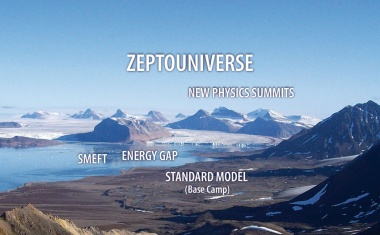 • 9/2020 • Seite 32 • DPG-Mitglieder
• 9/2020 • Seite 32 • DPG-MitgliederFlavour experiments promise insights into energy scales as high as 200 TeV and distances as small as 10−21 meter and offer the chance to identify New Physics.
The Large Hadron Collider (LHC) at CERN will directly probe distance scales as short as 10–19 m, corresponding to energy scales at the level of a few TeV. Presently, higher resolution can only be achieved with the help of quantum fluctuations caused by new particles and new forces that act at very short distance scales and modify the predictions of the Standard Model of particle physics for very rare processes. In this context, weak decays of mesons and leptons play the prominent role besides the transitions between particles and antiparticles in which flavours of quarks and leptons are changed. In this manner, information about the Zeptouniverse corresponding to energy scales as high as 200 TeV or distances as small as 10–21 m can be obtained.
The year 1676 was very important for humanity, because Antoni van Leeuwenhoek discovered the empire of bacteria. He called these small creatures animalcula (small animals). His discovery was a milestone in our civilization for at least two reasons: He discovered creatures invisible to us which have been killing humans for thousands of years, often responsible for millions of deaths in one year. While Antoni van Leeuwenhoek did not know that bacteria could be dangerous for humans, his followers like Louis Pasteur, Robert Koch and other „microbe hunters“ realized the danger coming from these tiny creatures and also developed weapons against this empire [1].
Van Leeuwenhoek was the first human who looked at short distance scales invisible to us and discovered thereby a new underground world. At that time, researchers looked mainly at large distances, discovering new planets and finding laws, such as the Kepler laws which Isaac Newton was able to derive from his mechanics. (...)
 • 2/2019 • Seite 24
• 2/2019 • Seite 24Donna Strickland needed a high-intensity laser pulse for her PhD thesis studies and, therefore, she developed the chirped pulse amplification.
Donna Strickland needed a high-intensity laser pulse for her PhD thesis studies and, therefore, she developed the chirped pulse amplification. The Nobel Prize in Physics 2018 was awarded “for groundbreaking inventions in the field of laser physics”. Arthur Ashkin shared one half “for the optical tweezers and their application to biological systems”. The other half went jointly to Gérard Mourou and Donna Strickland “for their method of generating high-intensity, ultra-short optical pulses”. Donna Strickland is the third woman to win a Nobel Prize in Physics. She was working on her PhD thesis in the group of Gérard Mourou when she performed the awarded research and she was the first author of the decisive paper.
Chirped pulse amplification was not the topic of your PhD thesis. Why did you work on it anyway?
I was the only person in the group that was working on a high-intensity laser project. I was supposed to measure the ninth harmonic of a YAG laser impinging on a nickel plasma. Therefore, I needed a short laser pulse with sufficient energy but pulse compression did not work.
Why not?
There was a number of reasons – one of them being self-focussing. Because the self-focussing length changes with the power not all of the pulse can focus to the same point in space. Gérard Mourou, my supervisor at the time, came up with the idea of the so-called chirped pulse amplification to overcome the problem. We scrapped what I was working on before and started with the new technique...

Neuanordnung schwerer Quarks in exotischen Elementarteilchen mit positiver Energiebilanz.
 • 7/2016 • Seite 24
• 7/2016 • Seite 24Quantenphasenübergänge lassen sich mittels chemischer Bindungen steuern.
 • 9/2015 • Seite 41
• 9/2015 • Seite 41Quantum fluctuations played a crucial role in the formation of the structure of our universe.
On March 21, 2013 something very remarkable happened. The Planck science team released a highly precise photograph of our universe when it was only few hundred thousand years old. This photograph is so detailed that it shows some major features that the universe acquired only 10–35 seconds after creation. Most strikingly, the observed nontrivial features in the portrait of such a young universe came in exact agreement with what had been predicted by the theorists more than thirty years ago, long before the experiment was carried out. Without any exaggeration one can say that by now it is experimentally proven that quantum physics, which is normally considered to be relevant in atomic and smaller scales, also played the crucial role in determining the structure of the whole universe, including the galaxies, stars and planets.
Of course scientists and philosophers have always been interested in the origin of our universe. However, cosmology only became a natural science less than a hundred years ago. It was not until 1923 that the American astronomer Edwin Hubble was able to resolve individual stars in the Andromeda Nebula and to conclude that for sure it is located outside of our own galaxy. This was the beginning of extragalactic astronomy. Today it is well established that there are about a hundred billion galaxies in our universe. Thus, the stars form galaxies with a size of about a hundred thousand light years. Moreover, the distance between neighboring galaxies is a few million light years. Observing the spectral lines of the galaxies, Hubble discovered that they are slightly redshifted. He interpreted this as a Doppler shift due to the relative motion of the other galaxies, which try to escape from us. Hubble also found that the spectral lines of galaxies further away show higher redshift. This means that they are escaping with higher velocities, proportional to the distance (v→ = H r→) and thus the universe expands. This discovery was the beginning of scientific cosmology.
With Hubble’s discovery it became clear that our universe is evolving as a whole. This did not come as a big surprise! In 1922 the Russian physicist Alexander Friedman had found that the generic solutions of the Einstein’s equations describe either an expanding or a contracting Universe. Assuming that the total mass of the universe is about a hundred billion times larger than the mass of our galaxy, Friedman was even able to conclude that the universe must be about 10 billion years old. Thus, Hubble’s discovery can be considered as a brilliant confirmation of the theoretical prediction by Friedman. The most important conclusion from Hubble’s discovery was that the universe was created about several billions years ago. This extremely important discovery remained for many years the single experimentally established fact in cosmology. Only after more than thirty years the other piece of the puzzle was discovered. ...
 • 9/2014 • Seite 37
• 9/2014 • Seite 37Life as a problem in nonequilibrium statistical mechanics
We review some problems in nonequilibrium physics from the point of view of statistical physics and differentiable dynamics. Specifically, we discuss the mathematical difficulties which inherently underlie applications to heat transport, to hydrodynamic turbulence, and to the study of life. The microscopic dynamics of transport phenomena (in particular heat transport) is necessarily non hyperbolic, which explains why it is a difficult problem. The 3D turbulent energy cascade can be analyzed formally as a heat flow, and experimental intermittency data indicate that this requires discussing a Hamiltonian system with 104 degrees of freedom. Life is a nonequilibrium statistical physics phenomenon which involves chemical reactions and not just transport. Considering life as a problem in nonequilibrium statistical mechanics at least shows how complex and difficult the study of nonequilibrium can be.
The aim of nonequilibrium statistical mechanics is to understand the properties of matter outside of equilibrium, starting from microscopic dynamics. At this time nonequilibrium statistical mechanics of transport phenomena close to equilibrium is a well-developed physical theory (due to the work of Onsager, Green, Kubo, etc. in the 1950’s, see for instance [1]). Away from this area, the theory of nonequilibrium is a program, or a variety of programs, rather than a theory. Here I shall make a choice, and describe an approach starting with classical Hamiltonian microscopic dynamics. From my point of view this approach has the interest that it uses nontrivial recent results in the theory of smooth dynamical systems, and that it sheds light on interesting physical phenomena: heat transport, hydrodynamic turbulence, and life. (...)
 • 1/2014 • Seite 35
• 1/2014 • Seite 35Die ungewöhnlichen Eigenschaften von Spins in Graphen geben noch Rätsel auf, versprechen aber Anwendungen.
Graphen ist ein Material der Superlative: Es ist nicht nur das dünnste und stärkste bekannte Material, sondern auch ein extrem guter elektrischer Leiter. In Graphen lässt sich aber auch der Spin der Elektronen über außergewöhnlich lange Strecken nahezu ungestört transportieren. Dieser weitere Rekord macht Graphen interessant für die Spintronik, die nichtflüchtige Arbeitsspeicher oder eine deutlich geringere Wärmeentwicklung auf Chips verspricht.
Wer Bleistifte zum Schreiben benutzt, hat möglicherweise schon einmal Graphen hergestellt. Bleistiftminen bestehen – abgesehen von etwas Ton, mit dem sich die Härte beeinflussen lässt – aus Graphit, einem Festkörper ausschließlich aus Kohlenstoff. Anders als Diamant ist aber Graphit sehr stark anisotrop, denn es besteht aus atomar dünnen Lagen, welche aufeinander geschichtet und nur relativ schwach aneinander gebunden sind. Beim Schreiben mit dem Bleistift werden diese Lagen abgeschält, wobei man wohl nur selten genau eine einzelne Lage des Materials aufs Papier bringt. Vor etwa zehn Jahren ist es jedoch Andre Geim und Konstantin Novoselov gelungen, durch wiederholtes Ankleben und Abziehen von Klebeband einzelne Lagen von Graphen zu isolieren. Die beiden Physik-Nobelpreisträger von 2010 haben diese Lagen allerdings nicht auf Papier, sondern auf Siliziumoxid abgelagert, welches die Oberfläche von herkömmlichen Mikrochips aus Silizium bildet. Siliziumoxid einer bestimmten Dicke eignet sich deshalb sehr gut, weil sich darauf einzelne Graphenlagen von Schichten aus zwei und mehr Lagen mit einem optischen Mikroskop unterscheiden lassen. Erst die Möglichkeit, einzelne Graphenflocken zu präparieren und mit elektrischen Kontakten zu versehen, hat es erlaubt, die erstaunlichen Eigenschaften dieses extrem dünnen Materials zu erforschen. Dieses Forschungsfeld ist inzwischen groß und wird es wohl auch bleiben, denn im Oktober 2013 hat die Europäische Union das über eine Laufzeit von zehn Jahren mit insgesamt einer Milliarde Euro dotierte „Graphene Flagship“ zur weiteren Erforschung der Grundlagen und Anwendungen von Graphen auf den Weg geschickt.
Graphen ist ein perfekt zweidimensionales Material, welches aus einer einzelnen Schicht von Kohlenstoffatomen besteht. Diese sind in der Ebene in einem hexagonalen Gitter angeordnet – ähnlich einer Bienenwabe (Infokasten „Struktur und Bandstruktur“). Neben dem mechanischen Abtrennen einzelner Schichten von Graphit mit der beschriebenen „Klebeband-Methode“ lässt sich Graphen auch durch epitaktisches Wachstum auf Siliziumkarbid oder durch Gasphasenabscheidung präparieren.
 • 9/2012 • Seite 41
• 9/2012 • Seite 41From disorder and quantum chaos to topological insulators
Quantum mechanical systems with some degree of complexity due to multiple scattering behave as if their Hamiltonians were random matrices. Such behavior, while originally surmised for the interacting many-body system of highly excited atomic nuclei, was later discovered in a variety of situations including single-particle systems with disorder or chaos. A fascinating theme in this context is the emergence of universal laws for the fluctuations of energy spectra and transport observables. After an introduction to the basic phenomenology, the talk highlights the role of symmetries for universality, in particular the correspondence between symmetry classes and symmetric spaces that led to a classification scheme dubbed the “Tenfold Way”. Perhaps surprisingly, the same scheme has turned out to organize also the world of topological insulators.
Let me begin by expressing that I feel greatly honored to be this year’s recipient of the Max-Planck medal, and I appreciate the opportunity to give a talk on some of the work that may have earned me this distinction. To set the stage and give you a flavor of what is to come, let me remind you of the old but still fascinating story of universal conductance fluctuations (UCF). Predicted theoretically in the middle of the 1980s by Altshuler [1] and by Lee and Stone [2], UCF was investigated in a large number of experiments. It was found that in a great variety of different mesoscopic systems − such as a small gold ring for example, or an even smaller silicon MOSFET − the electrical conductance displays characteristic fluctuations of the order of one when expressed in units of the conductance quantum e2/h (Fig. 1). What is most remarkable is that the size of the fluctuations in a broad range of parameters does not depend on the system dimension, the disorder strength, etc., but only on a few fundamental symmetries.
It was realized early on that there exists a close connection with the fluctuations that had been observed decades earlier in the scattering cross section of slow neutrons on atomic nuclei. This far reaching connection is at the very root of what I have to say. It led, among other things, to the development of a broad framework in which to model and calculate mesoscopic effects such as UCF. ...
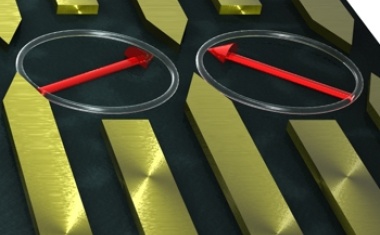
Neue Methode erlaubt individuelle Bestimmung von miteinander gekoppelten Quantenbits.
Mesoscopic physics is a sub-discipline of condensed-matter physics that focuses on the properties of solids in a size range intermediate between bulk matter (macroscopic) and individual atoms (microscopic). In particular, it is characteristic of a domain where a large number of particles can interact in a quantum-mechanically correlated fashion. In this article, it is shown that the collective spins of large and complex magnetic molecules can be tuned between their classical and quantum regimes thus enabling studies at the border of the two.
The magnetic moment or "spin" of an individual electron is an unimaginably tiny quantity. It is so small that it was only during the past few years that it became possible to detect single spins in solids, manipulate them and directly study their behaviour. Special spin memory devices have been developed that enable the optical generation of single charges in semiconductor artificial atoms. Remarkably, the spin of these charges can be programmed by the polarisation of the photons used to create them. Localising spins in such nanostructures dramatically suppresses their coupling to the outside world, making them potentially useful for quantum information processing.
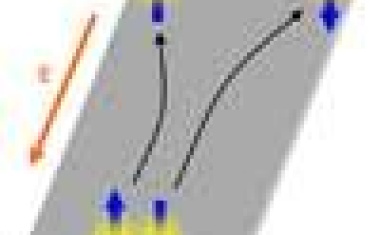
Die Trennung unterschiedlich orientierter Elektronenspins ist auch ohne Magnetfeld möglich - und das sogar bei Zimmertemperatur.
Elektronen besitzen nicht nur eine elektrische Ladung, sondern auch einen Spin. Die Nutzung dieses in der Halbleiterelektronik bisher vernachlässigten Freiheitsgrades könnte den nächsten Entwicklungsschritt in der Welt der Elektronik bedeuten und das Zeitalter der Spinelektronik, genannt Spintronik, einläuten. Was sind die grundlegenden Prinzipien dieser neuartigen Elektronik, welche Vorteile verspricht sie gegenüber den herkömmlichen Methoden, welche Fortschritte haben wir bereits gemacht und welche physikalischen Probleme müssen noch gelöst werden?
Thin liquid films have properties that can be different from the bulk material. We have studied freely suspended films of polyelectrolyte solutions, that means films with two liquid-air surfaces. We were able to show that the forces between surfaces are oscillatory, revealing stratification, i. e. a structuring in layers of thickness equal to the polymer network mesh size. The stratification kinetics reveal interesting differences when the surface conditions are changed.
The concept of quarks and leptons as the basis for the understanding of the fundamental structure of matter and forces was established in the late sixties and early seventies, culminating in the discovery of the J/ψ particle in the so-called ''November revolution'' of 1974. This particle was subsequently interpreted as the bound state of a new heavy quark, the charm quark, and its antiparticle. The subsequent discovery of the heavy lepton, the τ, and the even heavier bottom and top quarks completed the picture of the fermion content of the Standard Model of particle physics.
During the last years there has been a rapidly growing interest in the field of cold molecules. This has obviously been inspired by the spectacular successes in the closely related field of cold atoms, which have recently been recognized by the award of the 2001 Nobel Prize in Physics to Cornell, Ketterle, and Wieman for ''the achievement of Bose-Einstein condensation in dilute gases of alkali atoms, and for early fundamental studies of the properties of the condensates.'' But molecules have much more to offer than simply extending the experiments already performed with atoms to more complex species.